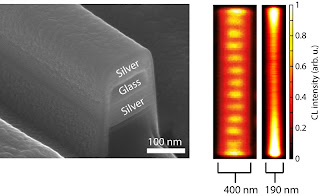Within a nanometer-scale device, visible light travels infinitely fast—by one measure—a team of physicists and engineers reports. The gizmo won't lead to instantaneous communication—the famous speed limit of Albert Einstein's theory of relativity remains in force—but it could have a variety of uses, including serving as an element in a type of optical circuitry.
In empty space, light always travels at 300,000,000 meters per second. In a material such as glass, it travels slower. The ratio of light's speed in the vacuum to its speed in a material defines the material's "index of refraction," which is typically greater than one. However, scientists have begun to manipulate the interactions of light and matter to tune the index of refraction in weird ways, such as making it negative, which leads to an unusual bending of light.
So how does an everywhere-at-once light wave not violate relativity? Light has two speeds, Engheta explains. The "phase velocity" describes how fast waves of a given wavelength move, and the "group velocity" describes how fast the light conveys energy or information. Only the group velocity must stay below the speed of light in a vacuum, Engheta says, and inside the waveguide, it does.
Science NOW: Nanoscale Device Makes Light Travel Infinitely Fast

Comments